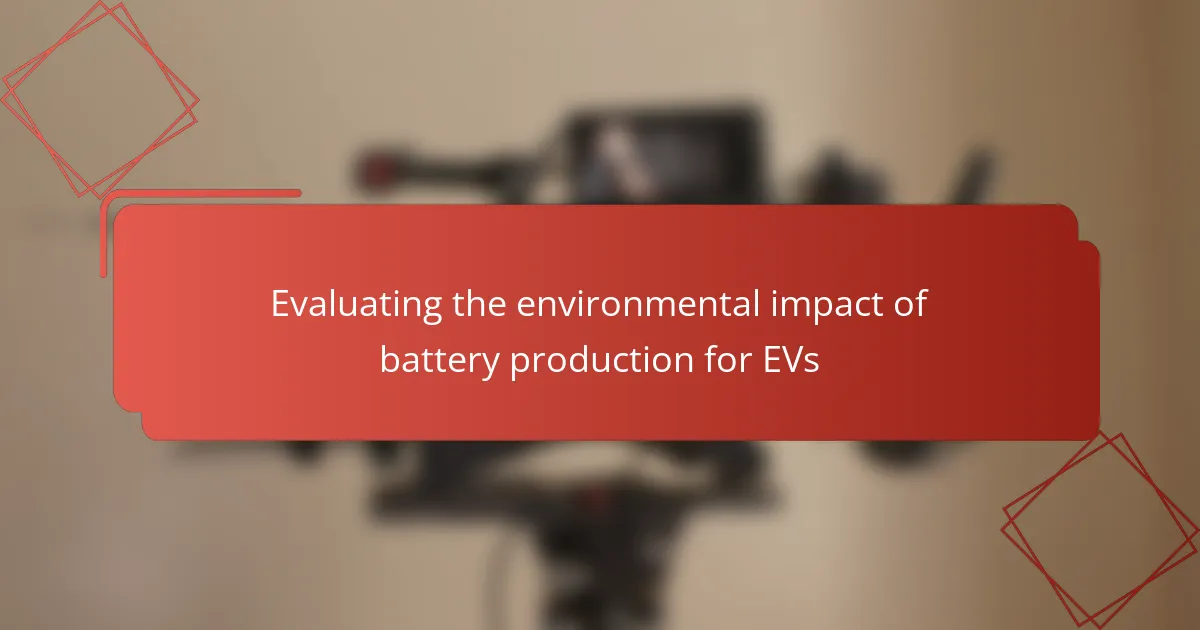The production of batteries for electric vehicles (EVs) poses significant environmental challenges, including carbon emissions, resource extraction, and water usage. Evaluating these impacts is essential for assessing the sustainability of EV technology. By exploring advancements in recycling, alternative materials, and energy-efficient manufacturing, we can work towards minimizing the ecological footprint of battery production.
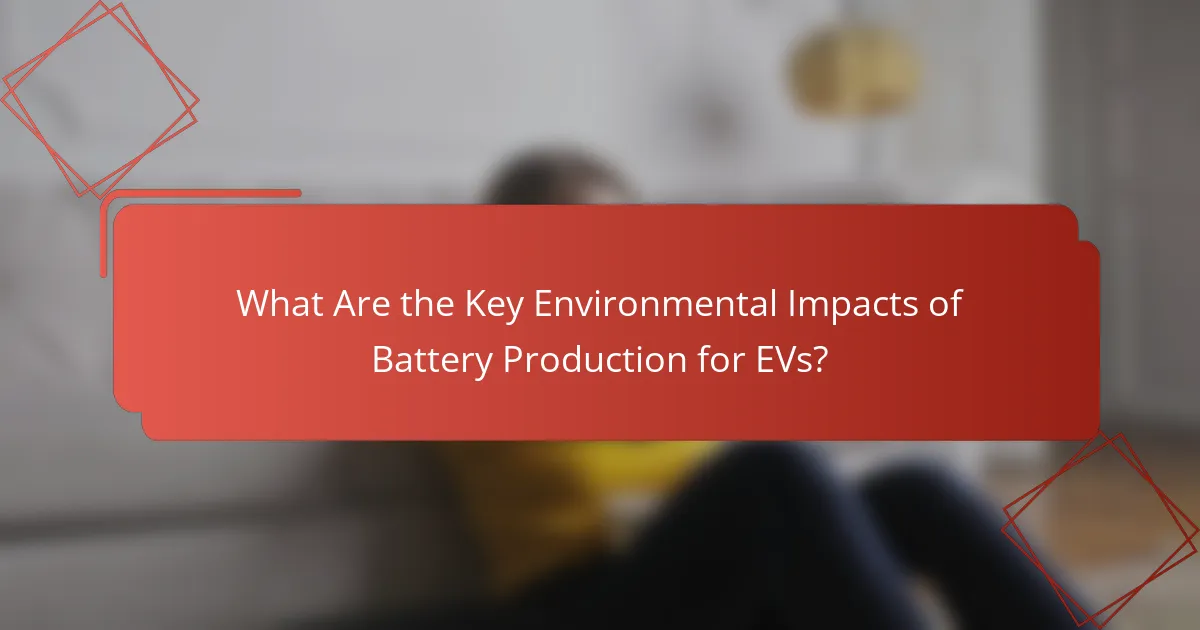
What Are the Key Environmental Impacts of Battery Production for EVs?
The production of batteries for electric vehicles (EVs) significantly impacts the environment through various factors, including carbon emissions, resource extraction, water usage, and disposal challenges. Understanding these impacts is crucial for evaluating the overall sustainability of EV technology.
Carbon emissions during production
Battery production, particularly lithium-ion batteries, generates substantial carbon emissions. Estimates suggest that the manufacturing process can produce several tons of CO2 per battery, depending on the energy sources used in production. Transitioning to renewable energy sources in manufacturing can help mitigate these emissions.
To reduce carbon footprints, manufacturers are increasingly adopting cleaner technologies and practices. For instance, using energy-efficient processes and sourcing materials from regions with lower carbon intensity can significantly lower emissions during battery production.
Resource extraction effects
The extraction of raw materials for batteries, such as lithium, cobalt, and nickel, poses environmental challenges. Mining activities can lead to habitat destruction, soil degradation, and pollution of local water sources. In regions like South America, where lithium is extracted from salt flats, the ecological balance can be severely disrupted.
Responsible sourcing practices, including recycling and using alternative materials, are essential to minimize the negative impacts of resource extraction. Companies are increasingly exploring methods to recycle battery materials, which can reduce the need for new mining operations.
Water usage and pollution
Battery production is water-intensive, particularly in the extraction and processing phases. For example, lithium extraction can require millions of liters of water, impacting local water supplies and ecosystems. Additionally, wastewater from mining operations can contaminate nearby water bodies, affecting aquatic life and local communities.
Implementing water management strategies, such as recycling wastewater and using less water-intensive extraction methods, can help alleviate these issues. Companies should prioritize sustainable practices to minimize their water footprint and pollution risks.
End-of-life disposal challenges
Disposing of EV batteries poses significant environmental challenges, as improper disposal can lead to toxic chemical leaks and increased landfill waste. Currently, a large percentage of used batteries are not recycled, which exacerbates the environmental impact. Establishing effective recycling programs is crucial for managing battery waste.
To address these challenges, manufacturers and policymakers are encouraged to develop comprehensive recycling frameworks that facilitate the safe disposal and recovery of valuable materials. Consumers should also be informed about proper disposal methods and recycling options available in their regions.
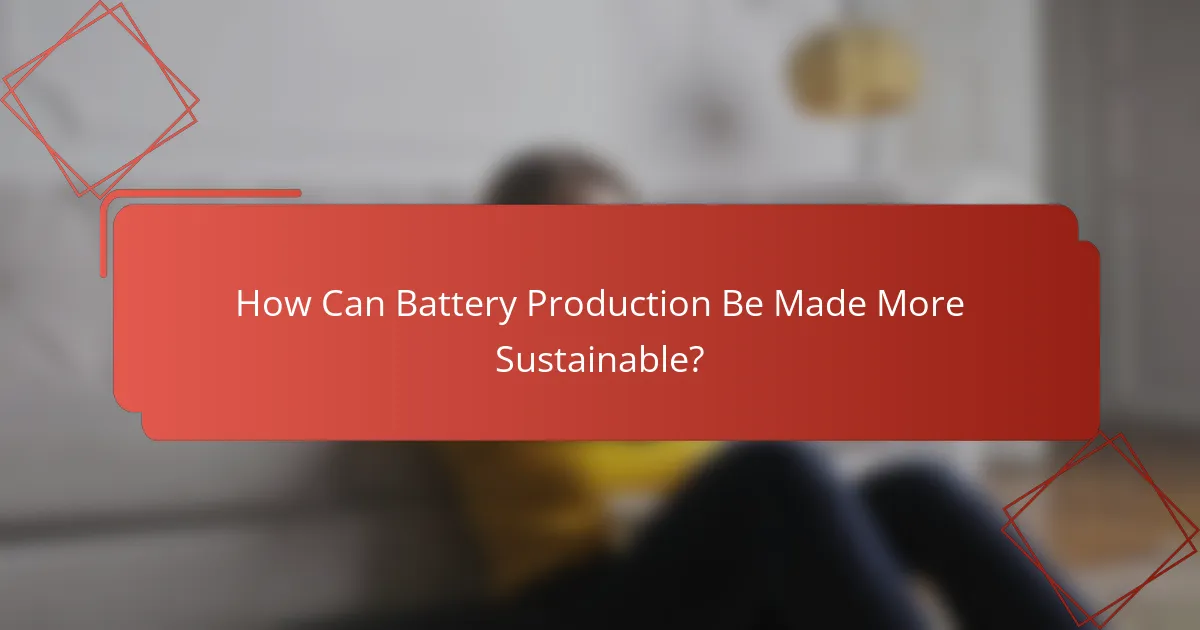
How Can Battery Production Be Made More Sustainable?
Battery production can be made more sustainable through advancements in recycling technologies, the use of alternative materials, and energy-efficient manufacturing processes. These approaches aim to reduce environmental impact while maintaining performance and safety standards.
Recycling technologies
Recycling technologies play a crucial role in making battery production more sustainable by recovering valuable materials from used batteries. Techniques such as hydrometallurgical and pyrometallurgical processes can extract lithium, cobalt, and nickel, significantly reducing the need for new raw materials.
Implementing effective recycling systems can also minimize waste and lower greenhouse gas emissions associated with mining and processing. Countries like Germany and Sweden have established robust battery recycling frameworks that serve as models for others.
Alternative materials
Using alternative materials in battery production can reduce reliance on scarce resources and lower environmental impact. For example, researchers are exploring sodium-ion and solid-state batteries as substitutes for traditional lithium-ion batteries, which could decrease the demand for lithium and cobalt.
These alternatives may offer comparable performance while being more abundant and less harmful to extract. Transitioning to these materials requires investment in research and development but could lead to more sustainable battery technologies in the long run.
Energy-efficient manufacturing processes
Energy-efficient manufacturing processes are essential for reducing the carbon footprint of battery production. Techniques such as optimizing production lines and utilizing renewable energy sources can significantly lower energy consumption during manufacturing.
For instance, factories powered by solar or wind energy can minimize reliance on fossil fuels, contributing to a more sustainable production cycle. Companies should prioritize energy audits and invest in technologies that enhance efficiency to achieve these goals.
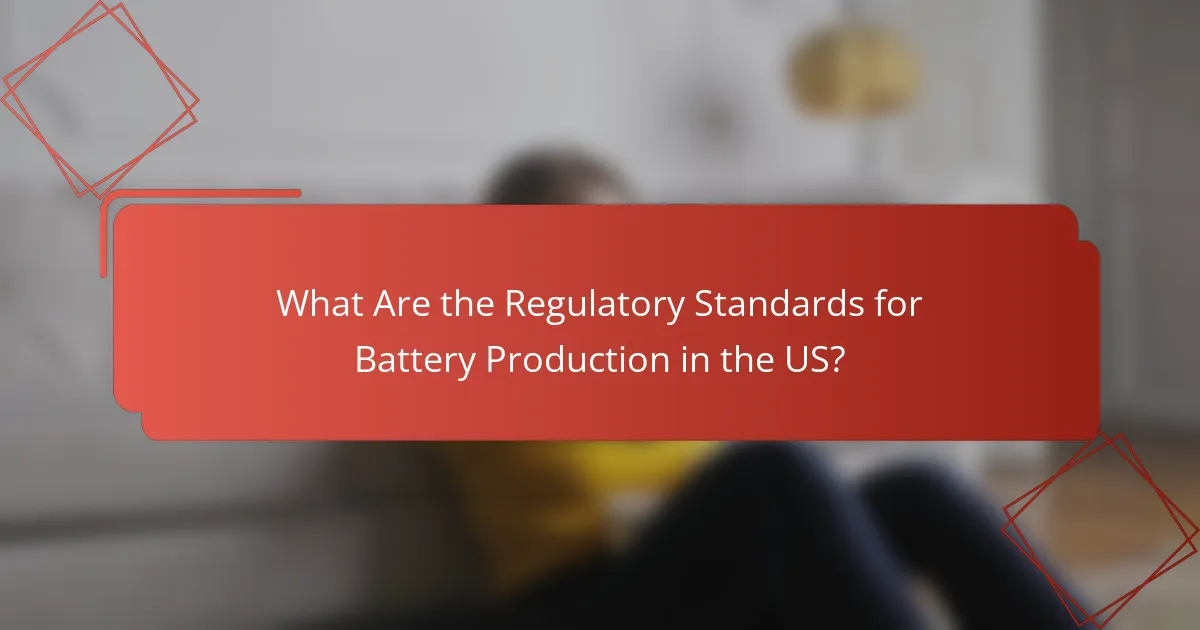
What Are the Regulatory Standards for Battery Production in the US?
Regulatory standards for battery production in the US focus on minimizing environmental impacts while ensuring safety and efficiency. These standards are enforced by various federal and state agencies, aiming to address issues such as waste management, emissions, and resource extraction.
Environmental Protection Agency (EPA) guidelines
The Environmental Protection Agency (EPA) establishes guidelines that govern the production and disposal of batteries in the US. These regulations include the Resource Conservation and Recovery Act (RCRA), which sets standards for hazardous waste management, and the Clean Air Act, which limits emissions from manufacturing processes.
Battery manufacturers must comply with these guidelines to avoid penalties and ensure sustainable practices. Regular audits and reporting are required to demonstrate adherence to these environmental standards.
State-level regulations
In addition to federal regulations, individual states may implement their own rules regarding battery production. For example, California has stringent laws aimed at reducing toxic substances in battery manufacturing and promoting recycling programs.
Companies operating in multiple states must navigate a complex landscape of regulations, which can vary significantly. Understanding local laws is crucial for compliance and can influence operational costs and practices.
International standards comparison
Internationally, battery production standards can differ from those in the US. The European Union, for instance, has established the Battery Directive, which emphasizes sustainability and recycling, mandating that a significant percentage of battery materials be recovered and reused.
Comparing US regulations with international standards highlights the varying approaches to environmental protection. Companies looking to expand globally should consider these differences to align their practices with local expectations and regulations.

Which Companies Are Leading in Sustainable Battery Production?
Several companies are at the forefront of sustainable battery production, focusing on eco-friendly practices and materials. Tesla, Northvolt, and LG Chem are notable leaders, each implementing unique strategies to minimize environmental impact.
Tesla’s battery recycling initiatives
Tesla has made significant strides in battery recycling, aiming to recover valuable materials from used batteries. The company has developed processes that can recycle up to 92% of battery materials, reducing the need for new raw materials and minimizing waste.
Additionally, Tesla is working on establishing closed-loop systems where recycled materials are reused in new battery production. This approach not only conserves resources but also lowers the carbon footprint associated with battery manufacturing.
Northvolt’s sustainable sourcing
Northvolt emphasizes sustainable sourcing of raw materials for its batteries, focusing on ethically mined lithium and cobalt. The company aims to source these materials from suppliers that adhere to strict environmental and social standards.
Northvolt’s commitment extends to using renewable energy in its production processes, which significantly reduces greenhouse gas emissions. Their factories are designed to operate with minimal environmental impact, aligning with European Union regulations on sustainability.
LG Chem’s environmental commitments
LG Chem has set ambitious goals to enhance its environmental commitments, including achieving carbon neutrality by 2050. The company is investing in advanced technologies to improve battery efficiency and reduce waste during production.
Furthermore, LG Chem is actively involved in developing recycling technologies that can reclaim materials from used batteries, thereby promoting a circular economy. Their initiatives are designed to meet global sustainability standards and contribute to a greener future for electric vehicles.
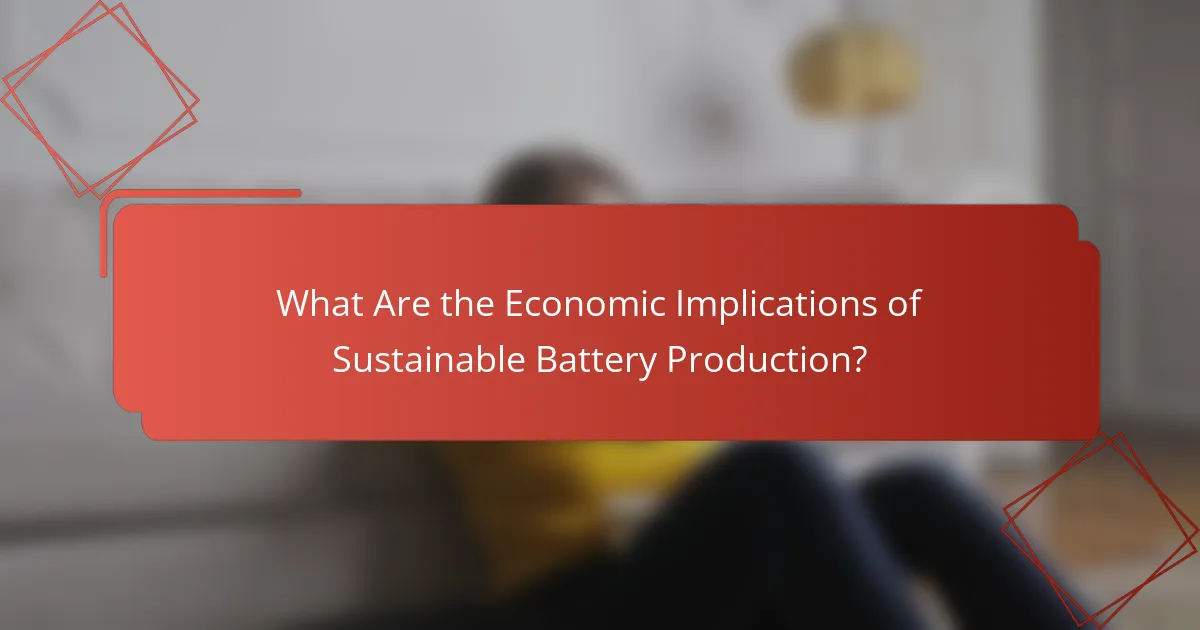
What Are the Economic Implications of Sustainable Battery Production?
The economic implications of sustainable battery production for electric vehicles (EVs) are significant, impacting costs, market dynamics, and investment strategies. Transitioning to sustainable materials can lead to higher initial costs but offers long-term savings and environmental benefits.
Cost of sustainable materials
The cost of sustainable materials for battery production can vary widely based on availability and technology. For instance, lithium and cobalt, commonly used in batteries, are subject to price fluctuations influenced by mining practices and geopolitical factors. In contrast, alternative materials like sodium or recycled components may offer more stable pricing over time.
Investing in sustainable materials often requires upfront capital, which can be offset by lower operational costs and improved recyclability. Companies should evaluate the total lifecycle costs of materials to make informed decisions.
Market demand for green technologies
Market demand for green technologies, including sustainable battery production, is on the rise as consumers and businesses prioritize environmental responsibility. This shift is driven by increasing awareness of climate change and government regulations promoting clean energy solutions.
As demand grows, companies that adopt sustainable practices may gain a competitive edge. For example, automakers that use eco-friendly batteries can attract environmentally conscious consumers, potentially increasing market share and brand loyalty.
Investment trends in battery innovation
Investment trends in battery innovation are increasingly focused on sustainability, with venture capital and government funding directed towards research and development of eco-friendly technologies. Investors are looking for companies that prioritize sustainable practices, as these are likely to yield long-term returns.
Emerging technologies, such as solid-state batteries and recycling processes, are attracting significant attention. Firms that innovate in these areas may benefit from lower production costs and enhanced performance, positioning themselves favorably in the evolving EV market.

How Do Consumer Choices Affect Battery Production Practices?
Consumer choices significantly influence battery production practices for electric vehicles (EVs) by driving demand for sustainable materials and ethical sourcing. As consumers become more environmentally conscious, manufacturers are compelled to adopt greener practices to meet these expectations.
Impact of EV adoption rates
Higher EV adoption rates lead to increased demand for batteries, which can strain production resources and impact environmental practices. As more consumers switch to electric vehicles, manufacturers must scale up battery production, often resulting in greater extraction of raw materials like lithium, cobalt, and nickel.
This surge in demand can prompt manufacturers to prioritize speed over sustainability, potentially leading to practices that harm ecosystems. For instance, mining operations for battery materials can result in habitat destruction and pollution if not managed responsibly.
To mitigate these impacts, consumers can support companies that prioritize sustainable sourcing and production methods. Researching brands and their supply chain practices can help consumers make informed choices that align with their environmental values.
